There is no shortage of things to do in Kaiserslautern, a charming and historic city just north of the sprawling Palatinate Forest in the German state of Rheinland-Pfalz. I’ve lived in the city of Kaierslautern and it’s surrounding area for several years, and think it’s a shame it is often overlooked by tourists. There are quite a few points of interest for history buffs, travelers, hikers, and newcomers to the area.

Kaiserslautern is particularly friendly to English-speakers since it is home to more than 40,000 American military personnel who live or work at the many surrounding military bases. It’s an interesting combination of German and American influences.
As always, the way to make sure you get the most out of your experience in any new place is to read up on its history. Even by European standards, Kaiserslautern boasts an extremely eventful history, and is rivaled by few cities in how many times it has changed hands (both politically and religiously) over the centuries. Here’s a two-minute history of this intriguing city to lay the foundations for your trip!
A Brief History of Kaiserslautern

Early and Medieval Times
Human settlements, confirmed by the discovery of Celtic graves in the Kaiserslautern area, date to as long ago as 800BC. But it wasn’t until the Middle Ages that the area got its name. The Lauter (“clear”) river flows near the city and it was the favorite hunting ground of Friedrich I, known as “Barbarossa” (Red Beard) who was King of Germany and Holy Roman Emperor from 1155 until his death in 1190AD. So “Kaisers Lautern” translates to the River of the Emperor.
King Rudolf von Habsburg of Austria officially chartered the town in 1276.
The Disappearing Lauter
Sadly the Lauter River which used to meander through the heart of Kaiserslautern, creating several ponds along its route, has been diverted and now runs mostly underground, invisible from above. This happened both for sanitary reasons, and to prevent the flooding that often caused problems. But it is a shame in some ways that the very namesake of the city is now only visible in bits and pieces.
If you are interested in seeing the old path of the river and finding what remains today, check out this great post about Tracing the Lauter Through Kaiserslautern by Brett at the Camping and Trekking blog.
Conflict Through the Centuries
Kaiserslautern’s tumultuous, and war-torn history includes a local noble named Franz von Sickingen who lived in the nearby Nanstein Castle in today’s town of Landstuhl. He converted to Protestantism in the 1500s during the Reformation. He had many skirmishes with Catholic forces in the surrounding towns and cities, but ultimately lost to the Catholics. The castle was destroyed, and Sickingen himself died under its rubble.

Read my post about the fascinating details of Nanstein Castle, and how to visit!
With the defeat of Sickingen’s forces, Kaiserslautern found itself front and center in the religiously motivated 100 Years War. They were occupied by Spainish Catholic forces, and then those forces were overcome by Swedish Protestant troops. Then in 1635 another particularly violent overthrow came when Croatian troops as part of the Austrian Army slaughtered 3,000 of the 3,200 residents of Kaiserslautern.
16th – 20th Century

But no peace was in sight yet. After the war, another period of French conflict saw many castles destroyed, including Barbarossa’s Imperial Castle which met its demise in 1713. Down, too, came the towers which had stood as part of Kaiserslautern’s old city walls.
Napoleon occupied the area as well, until his defeat at Waterloo in 1815 at which point Kaiserslautern became part of Bavaria, until after World War 1. Then, back to the French for several more years.
But it was World War II that saw the greatest destruction of Kaiserslautern. The area was industrial, close to the border with France, and a prime target for Allied bombing raids which destroyed between 60-85% of the city. The city surrendered to US troops in March of 1945. After the war it became part of the French Occupied Zone, and finally gained its established boundaries within Germany in August of 1946.
Kaiserslautern Today
Today, Kaiserslautern is home to about 100,000 people, a thriving university system, a very popular soccer team, and an extensive American military and civilian community which adds about 45,000 residents to the Kaiserslautern area. This makes it the world’s largest US military community outside the United States. As a result, many people in the tourist sector and in all service industries have great English skills.
There is also a vibrant food, bar, and music culture influenced by the presence of U.S. forces. The area is known by the military as “K-Town,” because supposedly it’s easier to say for English speakers. But the proper pronunciation of Kaiserslautern isn’t really that difficult, so I prefer to think of it as an affectionate nickname.
Best Things to Do in Kaiserslautern
1. Visit the Stiftskirche (Collegiate Church)
Marktstraße 13


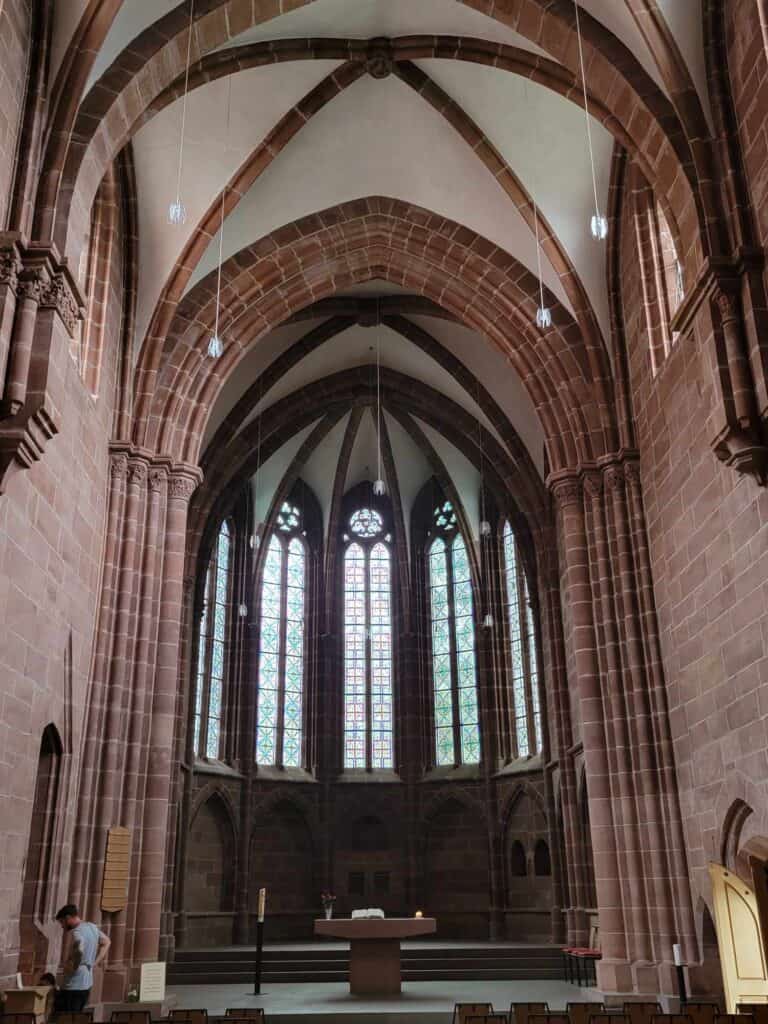


A good place to start is with the building that is its most iconic and sits in the beating heart of Kaiserslauterns old market square. The Stiftskirche (Collegiate Church) is not only the oldest church in Kaiserslautern, it’s the oldest Gothic hall church between the Rhein and Saar Rivers.
Created from the ubiquitous red sandstone mined in the area, the church was constructed in the mid-13th century on the foundations of a 12th century monastery and hospital commissioned by Emperor Freidrich I “Barbarossa”.
During the Reformation in the 1500s, Kaiserslautern adopted the new Protestant faith inspired by Martin Luther. But things did not go smoothly. From 1624 to 1734, the collegiate church changed from Protestant to Catholic, and back again, nine times! It now serves as an active Protestant church.
During World War II, the church was severely damaged by bombing. Restorations from 1946 to 1950 included a simplification of the main tower which had collapsed.
The bells of Stiftskirche ring on the quarter hour, and their beautiful and distinct sound has become an iconic part of Kaiserslautern’s old city center.
2. Relax in Stiftsplatz

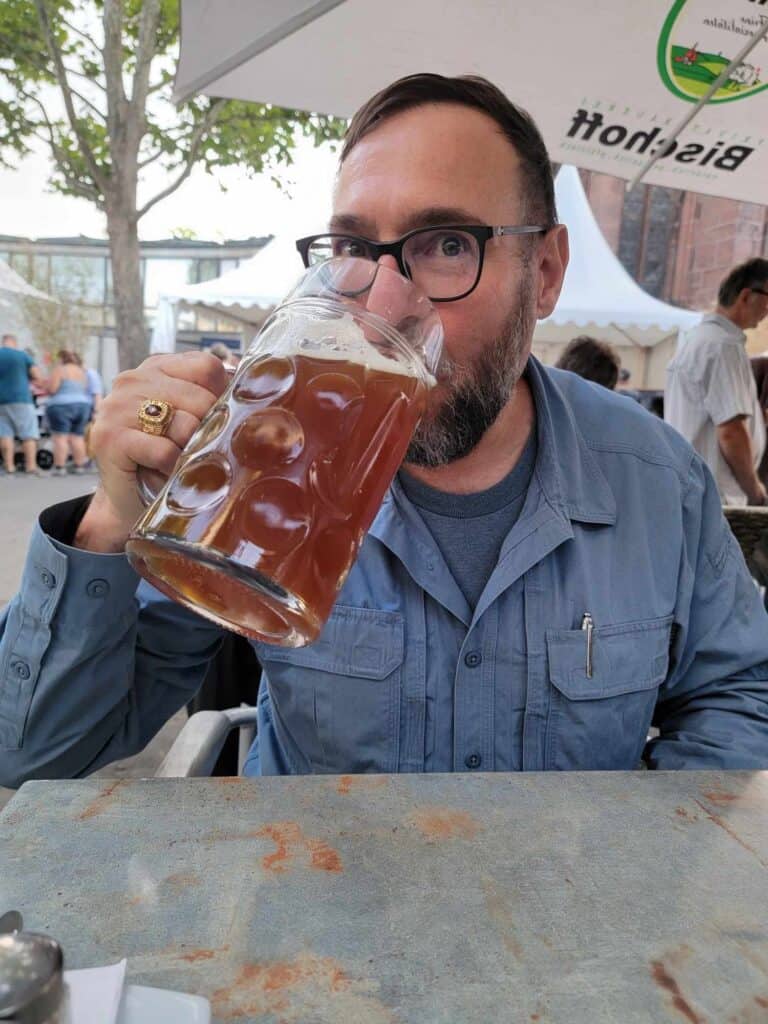
The square or ‘platz’ in front of the Stiftskirche has some interesting history of its own.
Adler Apotheke
In 1806, the then-dilapidated Richardis Chapel, built in 900AD and incorporated into the Stiftskirche, was demolished. The mayor of Kaiserslautern at that time also happened to be the pharmacist… and he built the Adler Apotheke (Eagle Pharmacy) on top of its sandstone foundation.
His own residence was right above the pharmacy. The Apotheke still stands today, looking much as it did then, with the 200+ year-old golden eagle perched over the door.
The Square
Fast forward to 1933. Just one day after fascists took control of the local government, a series of anti-fascist rallies began in Kaiserslautern. A large-scale rally of the social democratic Iron Front with over 3,000 participants assembled on the Stiftsplatz to protest the Nazis. Unfortunately, it didn’t take long for anyone speaking out against fascism to find themselves harassed, jailed, or worse.
By May of that year, the Hitler Youth held a large rally of their own on the Stiftsplatz. After sweeping through the town with hand carts, collecting books of “un-German spirit” they piled them in the square and set them on fire.
The Fruchthalle
Fruchthallestraße 10
Located nearby is the Fruchthalle, another iconic landmark, and a stunning example of neoclassical architecture. Today it serves as a music and events venue. Built in the 1830s and modeled after the Medici Palace in Florence, the Fruchthalle (fruit hall) was originally built as a space for merchants and farmers to buy and sell produce and other goods, and it became a hub of both social and economic activity.
It was also used throughout the years as a gathering place for events, and political rallies – everything from the Palatinate Revolution, to rebellion against Bavaria, to Nazi propaganda rallies.
It’s almost hard to imagine all that today in such a beautiful, warm, and welcoming place. Finding a spot to sit, watching the fountain, listening to the bells, or enjoying a beer and a bite to eat in one of the many outdoor restaurants in the Stiftsplatz is one of my favorite things to do in Kaiserslautern.
3. Find the Carp!
You may notice while walking around the city, that scattered everywhere from man hole covers to city buildings, and even art installations feature a fish. Here’s why!
According to local legend, in the year 1497 a carp was caught in the lake called the Kaiserwoog (Emperor’s Lake). The Kaiserwoog is one of the ponds which no longer exists after the Lauter River was sent underground.




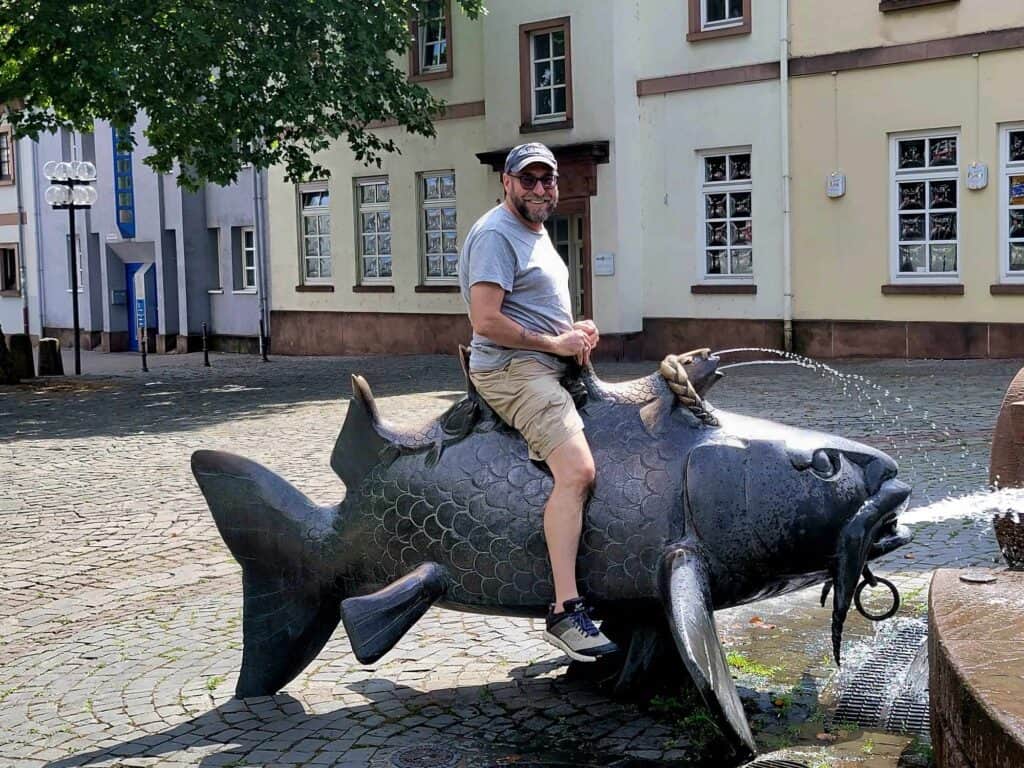
But this wasn’t just any carp – this one was supposedly a whopping 6 meters (20 feet) long! And on top of that, inside the carp was purportedly a gold ring with an inscription saying that the carp had been placed in the lake by Barbarossa’s grandson, Friedrich II in the year 1230. That’s one very big, very old carp! Henceforth, the carp was proudly featured front and center on the city’s red and white coat of arms.
So keep your eyes open for appearances by this legendary carp all over the city!
4. Wander in the Japanese Garden (Japanischergarten)
Am Abendsberg 1






The Japanese Garden in Kaiserslautern opened in 2000, and is the largest Japanese garden in Europe measuring over 140,000 square feet (13,500 square meters)! The city collaborated with Japanese garden designers for this epic project with the aim of creating an authentic experience of visiting a Japanese garden in Japan, and to foster a deeper cultural connection between the countries.
It really is a beautiful experience, with winding footpaths, gentle slopes, a pond, and garden features like Buddha statues, Japanese lanterns, and iconic Japanese bridges and stepping stones.
You’ll find many traditional Japanese garden plants too, like azaleas, bamboo, cherry trees, and Japanese maples. The plants evolve, bloom, and change through the seasons meaning that any time of year you choose to visit, the Japanese Garden will show a different side of itself and offer a unique experience.
The beautiful and tranquil pond is the central feature of the garden, and it’s stocked with colorful koi! There’s even a sign with a guide to help you identify all the different types of koi you’ll see in the pond.
There is also a traditional Japanese tea house! Built with authentic materials, and adhering to the principles of Japanese architecture, the tea house hosts tea ceremonies throughout the year, where you can witness and participate in a traditional Japanese tea ceremony.
Nearby you’ll also find a small pavilion with seating, providing a shaded area to enjoy the stunning views of the garden.
The garden is funded solely with donations and entrance fees. Tickets for an adult are €6,50 in the summer and €5,50 in the winter. Children are free. For all the particulars, visit the official website of the Japanischer Garten Kaiserslautern.
There’s a large paid parking lot right across the street, and it’s about a 20 minute walk from the train station, and a 5-10 minute walk from the Old Town. Maps and directions can be found here.
If you want to see what the garden looks like right now, check out their webcams which refresh every few minutes!
It really is worth a visit to this serene and meditative space. It’s become a favorite both for locals and visitors.
5) Visit the Synagogue Memorial and Solpersteine Markers
Fischerstraße and Luisenstraße




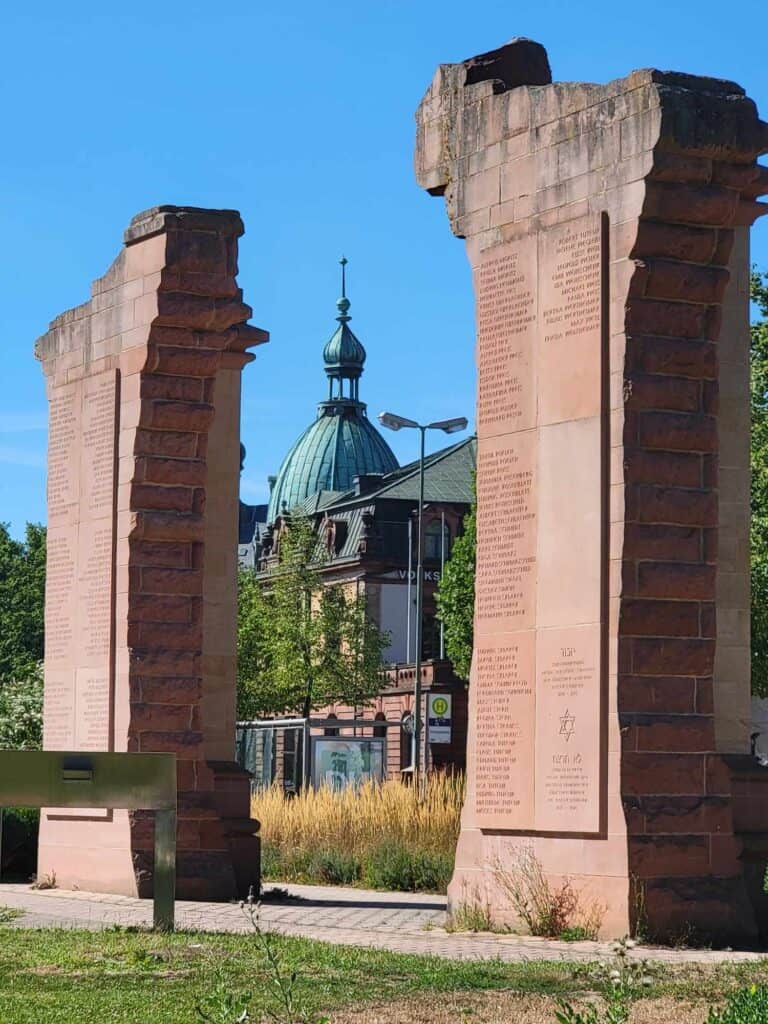



Kaiserslautern once boasted one of the most stunning religious buildings in the region – the magnificent Kaiserslautern synagogue, built in the Moorish revival style. The synagogue’s great dome towered over the city, and the building housed religious services for the local Jewish community, and added an incredible piece of architecture to the city.
The Nazi government, however, was determined to get rid of it. Hitler wanted to have a parade, and the synagogue was in the way, they said. So the Jewish community was forced to sell the building for a small sum which they never received. Then on August 31, 1938, (even before Kristallnacht) after a farewell service, the synagogue was torn down. The final demolition effort used explosives to blow up the remaining parts that were standing.
Soon afterwards, Kaiserslautern’s Jewish citizens were systematically taken from their homes, and places of work, and deported to concentration camps where most were murdered.
Today, the site of the Synagogue has been turned into a memorial which was completed in 2003. After the Nazi bombing, part of the front wall still remained standing, and the arch pieces were reconstructed using red sandstone with the names of Kaiserslautern’s 192 victims of the Holocaust etched on them.
Binoculars have been placed around the empty square and offer ghostly views of what once stood, from seven different angles. A row of boxwood hedges outlines the footprint of the building, and benches surrounded by roses offer places to sit.
You will also notice around town small bronze plaques called Solpersteine or “stumbling stones” with the names of Holocaust victims and what happened to them. Markers were installed in front of their last known residences, offering a sad but necessary reminder of Kaiserslautern’s darker past.

Here is a list of all the Solpersteine you can find in Kaiserslautern.
6) Enjoy Gartenschau Kaiserslautern (the Dino Park!)
Lauterstraße 51
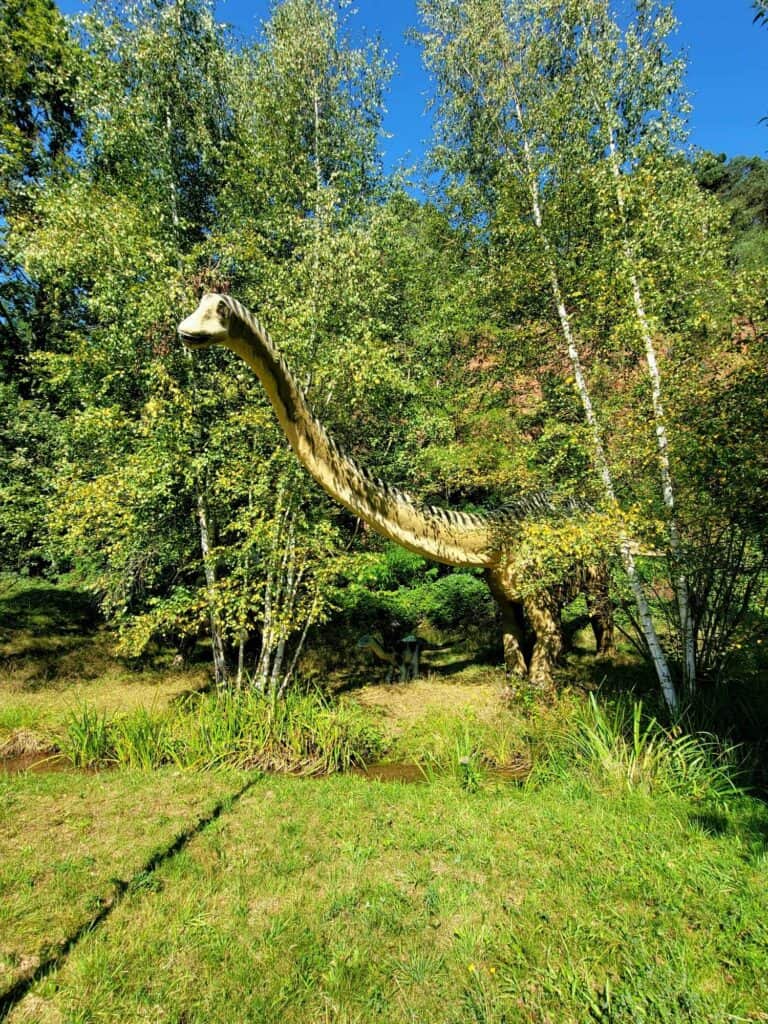



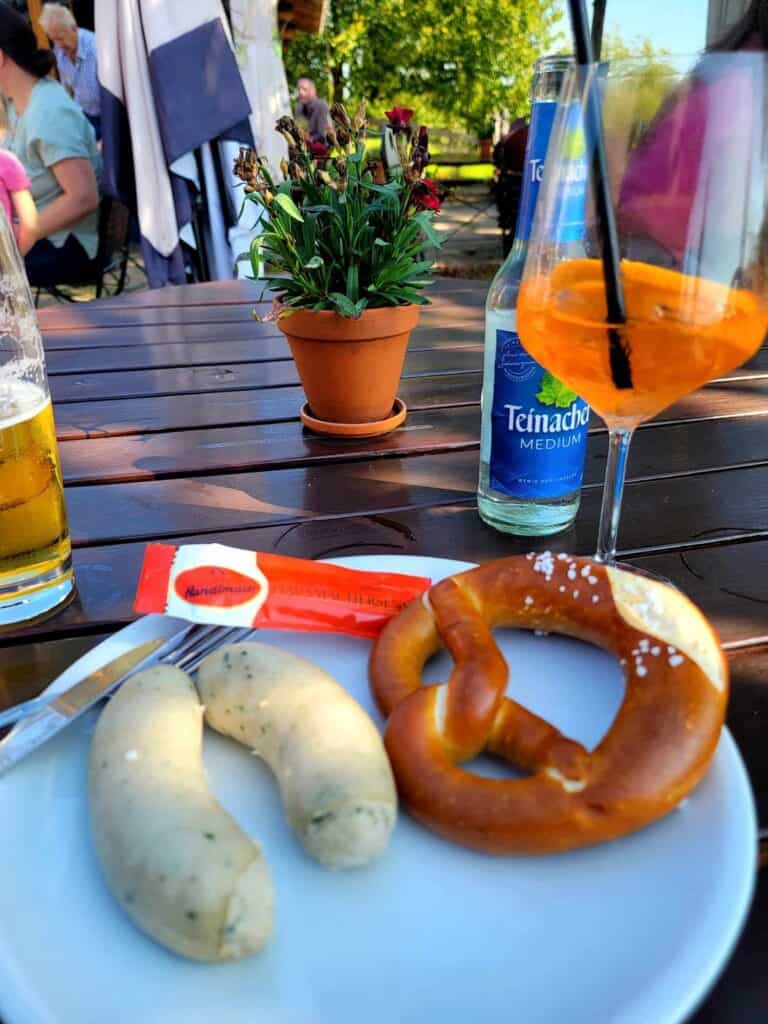

The Kaiserslautern Gartenschau (“Garden Show”) is commonly called the Dino Park, and the reason will become clear to you very soon after entering! Scattered throughout this stunning and serene multi-level city park are dozens of colorful life-sized dinosaur models.
But don’t think this park is just for kids. There’s a wide selection of beautiful spaces for picnics, bocce, forest hiking, and grabbing a beer and brat with a view to die for!
The park is open from April through October and hosts a variety of events and concerts. It really is a great venue to while away an afternoon.
Read our detailed post with lots of photos about the Dino Park in Kaiserslautern!
7. Grab a Bite at the Spinnrädl
Schillerstraße 1
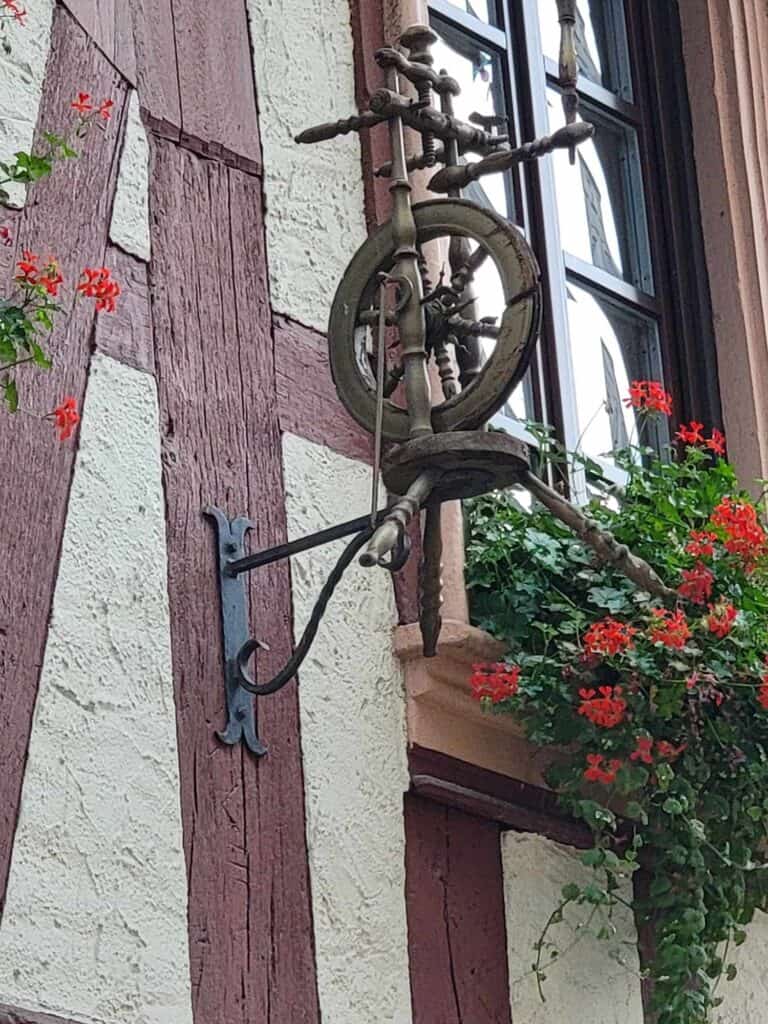
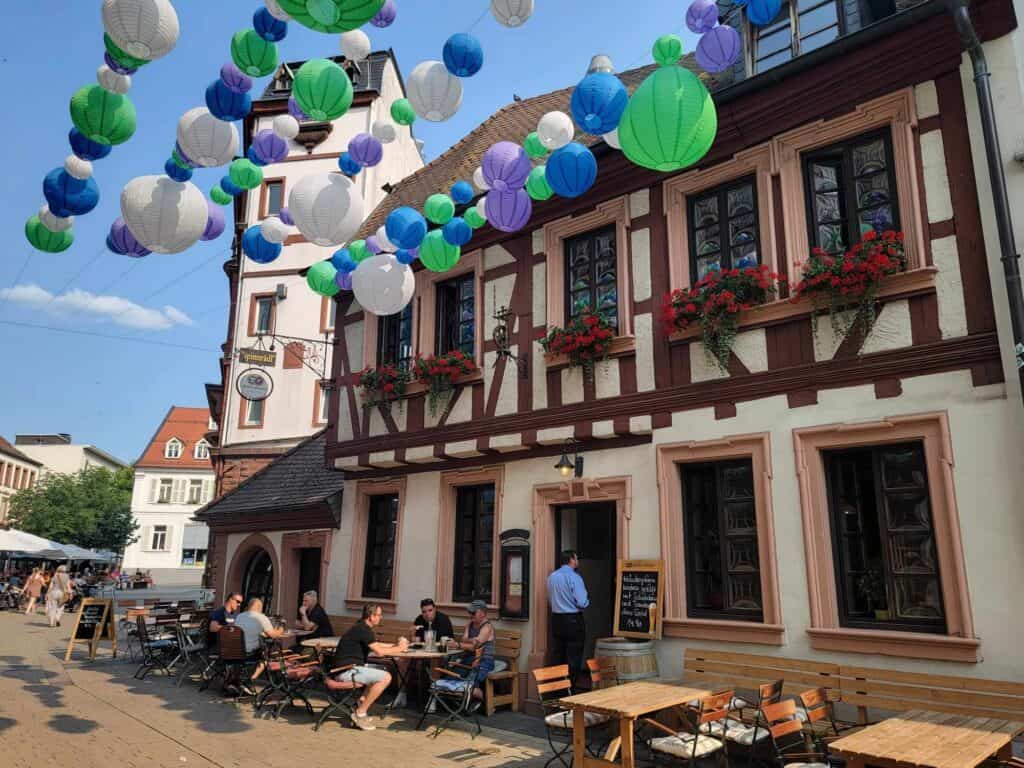

One of my absolute favorite things to do in Kaiserslautern when I have guests in town is to take them to the historic restaurant Spinnrädl! Located just off the Stiftsplatz, this aggressively charming little house is the oldest half-timbered building in the city!
There is some dispute about its age. It first showed up in the city registry in the year 1742, but they found a stone in the wall of the building with the year 1505 carved on it, so it could be even older than they first thought!
Through its recorded history it was most often used as a butcher shop. In 1856 a wine tavern was added.
Destined for demolition because it blocked traffic, it was quickly discovered that the building was half-timbered. Its original design wasn’t obvious because it had been plastered over. After discovering its age and historical importance, the building was saved, restored, and now serves as a really great restaurant.
Spinnrädl serves a great lineup of German classics like schnitzel and brats, and literally the best cheesy spaëtzle with carmelized onions I’ve ever had. There are also traditional local Palatinate dishes like liver dumplings, and saumagen which is a stuffed pig stomach – for the adventurous.
Spinnrädl (spinning wheel) is a real favorite with locals and tourists alike, and has a great atmosphere to go with the fabulous eats! Do call or email for reservations especially during the summer months.
8. Say Hello to Bretzeladam
Osterstraße 7
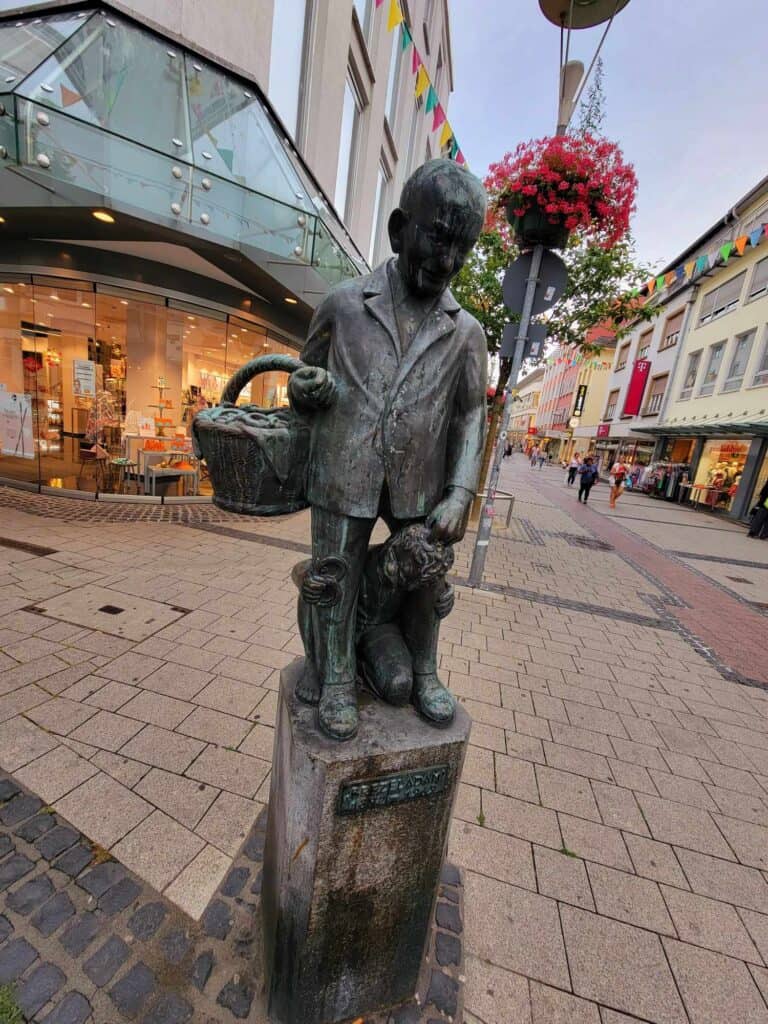
Every city seems to have one resident with such an outsized personality and impact on the community that their loss is really felt. Such it was with ‘Bretzeladam’ or Pretzel Adam. His real name was Adam Schmadel, and he was born in 1892. His family moved to Kaiserslautern for factory work when he was a baby.
Adam worked in the factory like his father, but like many Germans after World War I, found himself unemployed. So at 27 he became a pretzel entrepreneur, selling pretzels to locals. He apparently had quite a sense of humor and quickly endeared himself to his customers, becoming a feature in the city.
For over 50 years Adam sold his pretzels and was even acknowledged by the mayor on his 75th birthday. He died in 1969 at the age of 77, but you can find his monument at the corner of Eisenbahn and Marktstraße. His bronze likeness is holding a basket of pretzels with a little boy at his feet.
9. Explore the Kaiserbrunnen (Emperor Fountain)
Mainzer Tor




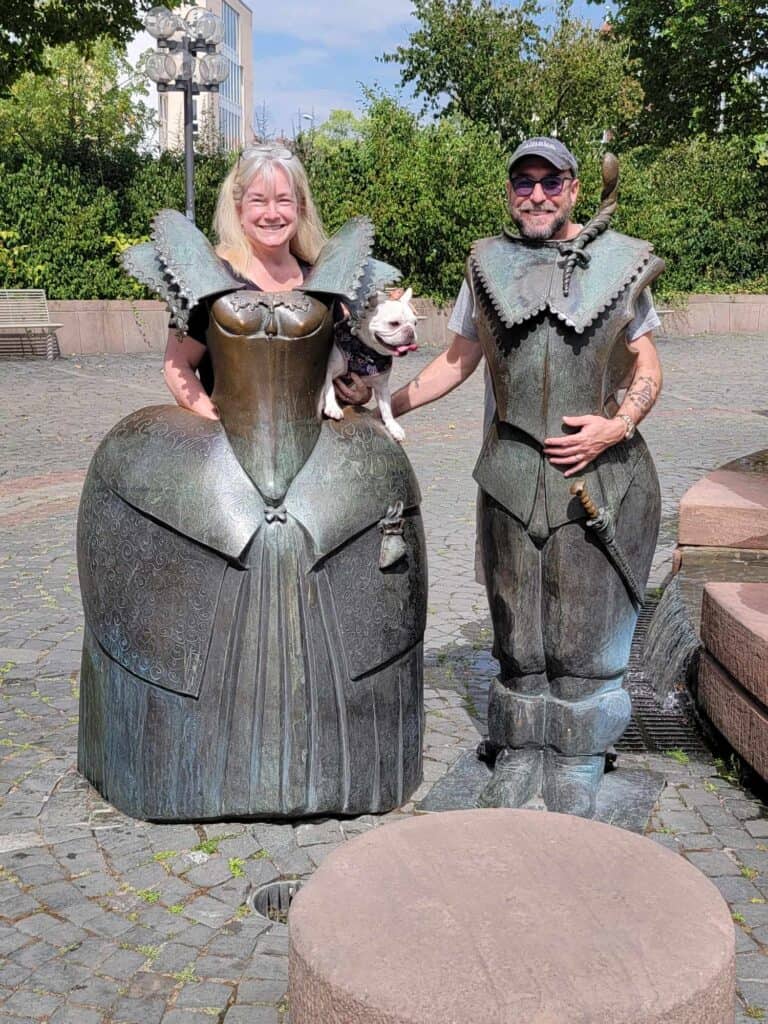

The Kaiserbrunnen, located right near St. Martins Platz, is one of the city’s most beloved landmarks. It is the creation of local artist Gernot Rumpf, and it blends history, culture, local lore, and humor to tell the unique story of Kaiserslautern.
Made of bronze and local red sandstone, it is full of symbolism, and is more than just something nice to look at. Many of the features allow you to interact with them as well, including that ever-present carp on the coat of arms. You’ll find mythical creatures local to the region, a Pfaff sewing machine and an Opel engine – two products of manufacture in Kaiserslautern.
There’s also a wise old spectacled owl for the university, a wagon of grapes for local vineyards, a soccer ball signed by local soccer legend Fritz Walter, a knight’s horse, Napoleon’s hat, and crowning it all – back to back – are the likenesses of Emperor Barbarossa and King Rudolph Hapsburg. There is much more to see than just that, and it will keep you busy for a while. Be sure to look for the tiny bronze mouse which is the signature of the artist.
10. Visit St. Martin’s Church (Martinskirche)
Klosterstraße 1






Architecture and Renovation
St. Martin’s Church was constructed around the year 1250, making it one of the oldest surviving structures in Kaiserslautern. Built by the order of Franciscan Friars, they established a monastery on the site. The location for the building was chosen for its proximity to the Lauter River, which sadly is no longer visible above ground.
Right by the entrance, though, you can see a statue of St. John of Nepomuk who is venerated as the patron saint of bridges, and water, standing at the site of the old bridge where the Lauter now flows underground.
Some early Romanesque influence is visible in the original structure, but its current appearance is mostly Gothic – including pointed arches, ribbed vaults, and large windows that were intended to bring light and a sense of the divine into the church. The Franciscan sense of simplicity is noticeable too.
Over the centuries, the church has undergone several renovations and restorations. In the 19th century some Neo-Gothic elements were added.
Miraculously, despite the heavy bomb damage to Kaiserslautern in World War II, St. Martin’s Church escaped with almost no damage, except unfortunately for its original stained glass windows. But architecturally it has retained almost all of its original character, making it especially noteworthy and a great place to visit.
The Reformation and St. Martin’s Church
Interestingly, during the Reformation period, a period of intense conflict between Catholics and newly-minted Protestants, St. Martin’s Church was used by both Catholics and Protestants who shared the space. This shared use sometimes led to problems and rivalries, but it also demonstrates some measure of rare coexistence in a turbulent era of religious division.
Today St. Martin’s Church serves as a local Catholic parish church, and if the doors are open visitors can enter and look around.
11. Find the Old City Wall
Klosterstraße 1


Right behind St. Martin’s Church on the far side of St. Martins-Platz you can discover something really amazing – remnants of the old medieval fortification walls from the 1200s!
Kaiserslautern was a formerly-walled medieval city of great importance. It sat on important trade routes, and next to the strategic and resource-full Palatinate Forest. The defensive network of structures included the wall, gates, towers, and even a moat!
During the 18th and 19th centuries most of the city walls, and all of the towers were torn down to allow for the urbanization and modernization of the city. The defensive purpose of the walls was considered obsolete, and when Kaiserslautern was under French and then Bavarian rule it lost most of its old Medieval buildings.
Fortunately this one segment of the wall was preserved, due to its close proximity to the church. And so an incredible part of Kaiserslautern’s history is still there for you to discover!
Be sure to check out the arrow slits that the archers used to defend the city from attackers. It’s pretty incredible to imagine what the city’s fortifications must have looked like.
12. Explore St. Martins-Platz


St. Martins-Platz is located right in front of St. Martin’s Church in the center of the old town of Kaiserslautern. This square and the Stiftsplatz are the most beautiful squares in the city.
The eastern part of the square used to be called the Kornmarkt (Grain Market) for the Medieval granary which used to stand there until it was demolished in 1808. And the western part was called “Auf der Brücke” which means “on the bridge.” Of course this was referring to a former bridge over the now-buried Lauter River which ran past the St. Martin’s Church.
St. Martin’s Square, like the church, was largely spared from the severe destruction of the city during the bombing raids of the Second World War. Several old and notable structures still remain.
On the north side of the square is a large archway with a coat of arms. To the left is the former Zum Donnersberg hotel where Victor Hugo once stayed in September of 1843 during a trip to Germany.
To the right of the archway is the Alte Stadthaus (Old City Hall) building. In 1968 city government moved to a newer building but the old one still stands and is used as a music school.
At the center of the square is the Fontaine Brunnen by Eduard Koelwel (1882–1966), one of my favorite fountains in the city, which was built at the end of the 19th century. It features a column with four white swans as a waterspouts. Above the swans there are two bowls and on the upper fountain bowl a little cherub.
There are also three large old chestnut trees in the middle of the square giving some nice shade and color.
Most of the other buildings on the square are now pubs and restaurants, may of which feature outdoor seating in nice weather. This is perhaps one of the loveliest and quietest places in the city for relaxed outdoor dining, and soaking up the beautiful architecture and atmosphere of the city.
13. See a 1. FCK Game at Fritz Walter Stadium
Fritz-Walterstraße 1





Go Red Devils! If you mention Kaiserslautern anywhere in the soccer-playing world, the first thing people think of is the Fußballclub Kaiserslautern (FCK). You’ll find their semi-startling (to English speakers!) logo everywhere – on stickers, in shops, on scarves and jackets, especially on game days!
The players are known as the Rote Teufel (Red Devils) because of their fierce reputation. They’ve won the German premier league four times, and boast an absolutely devoted and enthusiastic fandom. Their home base is the Fritz Walter Stadium in Kaiserslautern, named for the captain of the World Cup Winning 1954 German National Team. Fritz Walter is a local hero and an absolute legend of German soccer.
I am not really a soccer fan, but I have to tell you, attending a home game in Fritz Walter Stadium was an absolute blast! The beer flows, the energy is through the roof, and the vibe is totally electric! The stadium is full of fans (including families), with the particularly enthusiastic devotees sitting in the Westkurve (west curve) of the stadium, shaking the floor and waving banners.The facility seats an incredible 49,780 fans, making it one of the largest stadiums in Germany!
I would highly recommend attending a game, just to experience a really fun and iconic part of local culture. The crowd is energetic, but never gets out of hand. It’s definitely not a hooligan culture, and I never felt uncomfortable.
Check out FCK’s official website for information about tickets, games, news, and FCK museum hours. Also look for life-sized models of soccer players scattered around the stadium area, and the “11 Friends” in the traffic circle!
14. Shop the Saturday Market
Next to Stiftskirche


Every Saturday from early morning until noon, the platz behind the Stiftskirche comes alive with market stalls filled with amazing goodies! From fresh local produce and flowers, to cheeses, meats, breads, and sweets, it’s all there. You won’t leave empty handed so be sure to bring a market basket or bag and grab some inspiration to take home, or use for a picnic.
There’s also coffee and light fare for breakfast at the market, and you can avail yourself of the many awesome outdoor cafés and restaurants surrounding the square when you’re finished your shopping adventure.
15. Have a Picnic in the Park


Looking for the perfect spot to take all your treats from the farmer’s market and go have a picnic? There are two great spots located close to downtown.
The Volkspark (People’s Park)
This park, created in 1925 as part of a movement to establish beautiful green spaces in the urban area covers 37 acres (15 hectares), and is one of the largest green spaces in the city, located close to the Fritz Walter Stadium.
The park even has a beautiful pond that often has ducks in it, fed by that elusive underground Lauter River! There are also plenty of benches and shade trees, and large grassy areas for relaxation and play.
The park is open year-round, from early morning until dusk. Admission is free.
This is a great park for dogs too! There are several walking paths, big green lawns, and dog waste stations at various places on the perimeter.
The Stadtpark (City Park)
78 Pirmasenser Str.
If you’re looking for a smaller, more intimate city park, the Stadtpark is a lovely spot right in the heart of the city. It’s about 12 acres (5 hectares), and is bordered with beautiful seasonal flower beds.
There’s a cool fountain, lots of benches and open green space, mature shade trees, and also a well-equipped playground for kids.
It was one of my favorite spots to walk my dog when we lived close by. There are nice walking paths throughout the space, and it really is a lovely little green gem right in the middle of the urban landscape.
Like the Volkspark it is open year-round from early morning until dusk and admission is free.
16. Check Out the Theodor-Zink-Museum/Stadtmuseum
Steinstraße 48


Near the Kaiserbrunnen you’ll find a restored 19th-century building located in the old downtown area of Kaiserslautern. Its exhibits showcase the Kaiserslautern’s history, from prehistoric times to its Roman habitation, to WWII and the modern era.
The region really has a fascinating cultural heritage that’s worth exploring.
Admission is mostly free, with one section that charges a fee but is only available in German. This hidden gem is recommended for those interested in local history or looking for something to do while wandering around town.
The permanent exhibition is dedicated to the history of the city of Kaiserslautern and the region and presents the most important events and artifacts from the earliest traces of settlement to the present.
The exhibition is a really great complement to all you will see around the city, and give you a chance to connect ancient artifacts as well as household items and things from the daily life of those who have inhabited the city over the millenia.
Several exhibition spaces are arranged chronologically, and allow you to walk through time experiencing the Bronze Age, the Middle Ages, the construction of the Imperial Palace, the Palatinate War, the Industrial Age, the World Wars including Jewish life in Kaiserslautern, all the way through an interesting assortment of consumer goods from the 20th century.
It also includes a beautiful courtyard and a barn you can explore.
The museum is open 10 am to 5 pm, Wednesday to Friday, and 11 am to 6 pm Saturdays and Sundays. The museum is closed on Mondays and Tuesdays.
The permanent exhibition is free. Special exhibitions are €5 for adults.
Information is only in German, so make sure your phone is charged up and use the camera feature on the Google Translate app if you need to translate the information cards.
17. Explore the Ruins of Hohenecken Castle




For a really beautiful hike to see an amazing castle ruin, I highly recommend checking out Hohenecken Castle. It is outside the city in one of the Kaiserslautern suburbs, but it’s well worth the trek.
This hike is fairly easy, well-signed, and you’ll be rewarded with some beautiful views of the little village of Hohenecker and the surrounding forest, and lots of awesome photo ops in a castle ruin that you’re free to roam and explore!
At the bottom of the trailhead is a cute village with several places to grab a bite to eat, and a local beer.
You can read details about the history of the castle, where to park, and other particulars at our article about Hohenecker Castle, or check out the video below.
18. Find the Views!
Humbergturm
For other great views you can hike to the Humbergturm (Humberg Tower) which is also a little outside of town. This stone observation tower was built in 1899 and stands about 120 feet (36 meters) high. It will take you 163 steps to reach the top.
New City Hall & Restaurant 21
Or if you’re more of an indoor view-seeker, you can check out the new City Hall that replaced the old Stadthaus in St. Martin’s Platz. At the time of its completion in 1968 it was the tallest city hall in Germany. On the 21st floor you can find Restaurant 21 which offers spectacular views and delicious food. This is the perfect spot to end a day of sightseeing. Reservations are recommended.
19. Discover the Pfalzgalerie
Built in 1874 to house solely a collection of applied arts, the Pfalzgalerie is one of the most important and oldest museums in the state of Rheinland-Pfalz. In 1903 it acquired an important collection of paintings, donated by the Munich Privy Councillor Joseph Benzino, who came from nearby Landstuhl.

The permanent collection now contains an impressive 900 paintings from the 19th – 21st century, sculptures, more than 15,000 drawings including works from Rembrandt and Picasso, and a varied collection of applied arts spanning the eras from Han Dynasty, to European Medieval, to Art Nouveau.
The collection suffered when Kaiserslautern fell under Nazi rule. In sweeping raids of modern and abstract paintings, and paintings by Jewish artists which the Nazis considered “degenerate art” eighty-six paintings were taken from the museum. The works included those of Ernst Barlach, Paul Klee, Max Beckmann, Emil Nolde, Harriet von Rathlef-Keilmann, and dozens of others. Many were destroyed.
The artworks were removed from the building and hidden as the war progressed. Allied bombing raids destroyed much of the museum but left the facade mostly intact. The museum was ultimately rebuilt with its facade intact, and the remaining artwork restored.
The permanent exhibit is free, and special exhibits run about €8 (free for students), and everything is free the first Saturday of the month.
You can check out the Pfalzgalerie’s official website for information on special exhibitions.
The museum is closed on Monday, and is open Thursdays from 11am-8pm, and all other days from 10am to 5pm.
It’s about a 5-minute walk from the train station.
20. Find the Ruins of the Imperial Palace and Casimir Castle


Very unfortunately, not much remains of this once epic building that served as a favorite residence of German King and Holy Roman Emperor Freidrich I, known in Kaiserslautern by “Barbarossa.” The ruins that remain leave only a hint at the original structure.
Historical Background
This palace complex, built in about 1152, was strategically situated in the Palatinate forest, which also served as an area of natural fortification. From here the Emperor could control both the surrounding land, and access to vital trade routes.
The Imperial Palace of Lutra, as it was known at the time, was the first palace built by Barbarossa during his reign, and it was one of the most famous and magnificent buildings of its kind in the entire empire.
It once included residential quarters, a chapel, ceremonial halls, and also defensive military structures, covering all the needs of his royal court.
The Casimir Castle
Tied to the Palace complex you’ll also find the Renaissance castle built by Count Palatine Johann Casimir in 1571. Count Palatine Johann Casimir moved to Kaiserslautern in 1570 and built a Renaissance-style castle next to the palace. He and his wife lived in Barbarossa’s palace while construction was underway. Even after construction, the continued to hold receptions in the Imperial Hall.
Decline of the Palace Complex
Following damage caused by the Croatian Invasion during the Thirty Years’ War and assaults from French troops in 1688, 1703, 1704, and 1798 the complex was pretty much leveled. The ruins were cleared away, with very little left to see today.
Today you can only see parts of the original stone foundation, some sections of walls, and parts of the palace chapel and main hall.
Underground Passageways
The coolest and most intriguing part of the ruins is the subterranean cellars and passageways which are still accessible. Don’t go in here if you are claustrophobic, as the passages are very narrow and winding. They were probably used to get from one part of the palace complex to another, and also for storage.
Occasionally English tours are available and you can find out the dates and times on the official website of the Imperial Palace ruins.
You’ll also find some educational plaques giving more historical context and information on the historical background.
21. Hike in the Stunning Palatinate Forest


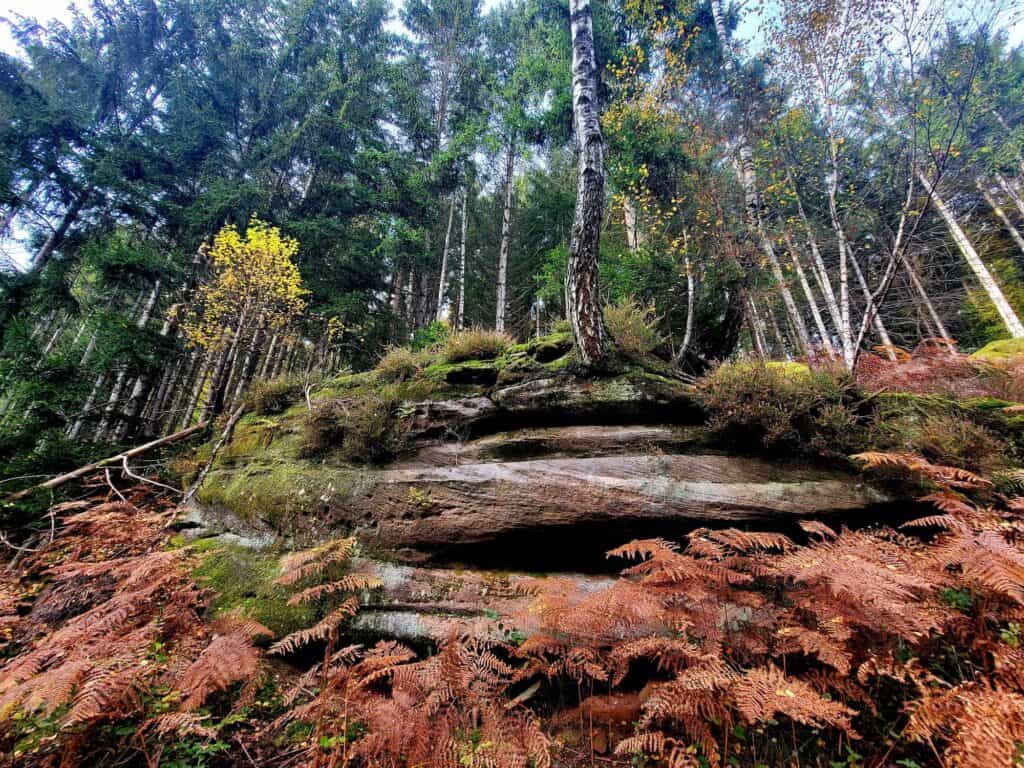
The crown jewel of the entire Pfalz region is without a doubt the huge and stunning Palatinate Forest, known as the Naturpark Pfälzerwald. The German forest meets its French portion in the Vosges Mountains and together this area of land is a UNESCO-designated site.
Hiking in the region is extremely popular both with locals and visitors who often travel great distances to enjoy this beautiful nature park. There are literally dozens of woodland car parks, and the area features benches, trash bins, beautifully manicured trails, breathtaking natural sandstone formations, and woodlands that look straight out of a fairytale.
These trails are suitable for hiking all year round, and each season brings its own gifts. Autumn is probably my favorite time, but it’s a hard choice. And if you’re not a “hiker” don’t be put off. Many hikes are very simple, and feel more like a beautiful stroll through the forest.
Check out this great website for a detailed list of the Top 20 Hikes and Walks Around Kaiserslautern, and be sure to enjoy one of the most unique and beautiful things to do in Kaiserslautern and its surroundings!
Enjoy All the Things to Do in Kaiserslautern!

As you can tell by now, I’m a big fan of this city and its surroundings. And it’s not just because of the things to do in Kaiserslautern. It really is an under-appreciated city, it is very English-friendly, less crowded than other places, the people are wonderful, and it has a fascinating mix of history, culture, beauty, and recreational opportunities. Enjoy your trip to this awesome city!
And if you’re looking for great day trips within two hours of Kaiserslautern, we’ve got you covered!
More City Guides to Europe’s Hidden Gems!
- One Day in Bamberg: Best Guide to Germany’s Medieval Beer Capital
- Best Messel Fossil Itinerary: 1 Day, 3 Stops, All the Highlights
- 46 Best Things to Do in Rothenburg ob der Tauber
- 11 Best Things to Do in Trier, Germany
- One Day in Aachen? Discover the Treasure!
- 11 Best Things to Do in Marburg, Germany’s Fairytale Town
- The Perfect Weekend in Cologne, Germany
- The 12 Best Things to Do in Epernay France
- 12 Incredible Things to See in Metz, France
- Ostuni the White City: Your Magical Gateway to Puglia
- The 7 Most Amazing Things to Do in Ravello Italy
- Is Pisa Worth Visiting? The Good and the Bad.
- Ravenna, Italy – Ultimate One-Day Itinerary!
- Altdorf Switzerland: Discover Where William Tell Shot the Legendary Apple
- 20 Amazing Things to Do in Poznan, Poland!
Be the first to know when we post new city guides and other helpful content about hidden gems in Europe!
